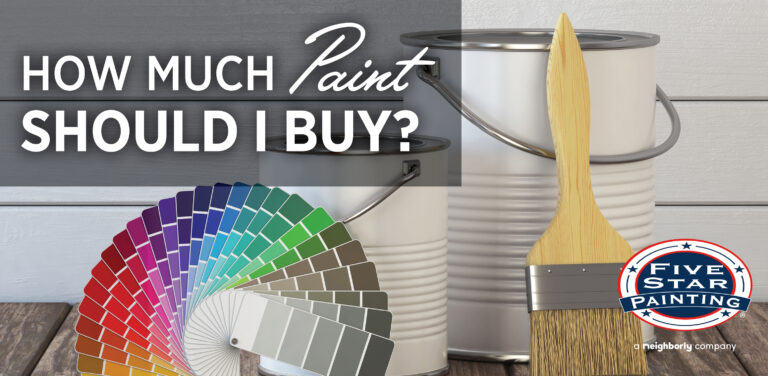In our years of home improvement, we’ve often come across the question, ‘Can we paint our vinyl fence?’ It’s a fair inquiry considering the appeal of a fresh coat of paint to spruce up the look of a weathered fence.
Sure, you can paint vinyl, but it’s not as straightforward as slapping on a coat of your favorite color. There’s a lot to consider, from the type of paint to use to the potential voiding of your fence’s warranty.
Now, you may be wondering if it’s worth the effort or if there are better alternatives. Well, stick around as we explore the pros and cons, and provide you with the knowledge to make an informed decision.
Key Takeaways
- Vinyl fencing is a durable and low-maintenance option that offers versatility in design and color.
- While painting vinyl fencing allows for customization and color change, it may not adhere well and can potentially damage the surface, voiding the warranty.
- Before painting, review the fence’s warranty to ensure its validity and understand any exclusions or limitations related to painting.
- Proper preparation, including cleaning, priming with a vinyl-specific primer, and using epoxy-based acrylic paints, is essential for a long-lasting and attractive vinyl fence.
Understanding Vinyl Fencing Material
When it comes to understanding vinyl fencing material, it’s essential to know that it’s a popular choice due to its durability, low maintenance, and versatility in design and color. As experts in the field, we’ve seen homeowners choose vinyl fencing for its ability to stand the test of time, enduring harsh weather conditions without chipping, cracking, or splintering.
The beauty of vinyl fences lies in their nearly maintenance-free nature. You won’t find us wasting time and effort on constant repairs. In fact, a simple wash with soapy water is usually all it takes to keep the vinyl surface sparkling clean. That’s the kind of ease we all want and deserve in our homes, isn’t it?
Understanding vinyl fencing material goes beyond appreciating its practical benefits. It’s about recognizing the possibilities it offers in personalizing our spaces. With a wide variety of designs and colors available, vinyl fencing can truly reflect our style and taste.
So, whether we’re marking property lines or keeping our beloved pets safe, we can do it with a fence that feels uniquely ours.
In the end, we all deserve a fence that’s not only sturdy but also speaks to our individuality. And that’s the promise of vinyl fencing.
Pros and Cons of Painting Vinyl
While we’ve highlighted the myriad benefits of vinyl fencing, it’s imperative that we also address the considerations involved in painting this material, namely the pros and cons.
The advantages of painting vinyl are clear. Painting allows for customization and color change to match personal preferences, enhancing your property’s appearance and curb appeal. Moreover, using the right paint and preparation can provide additional protection against UV rays and weathering, potentially extending the lifespan of your fence.
However, the question ‘can you paint vinyl fence?’ isn’t without its caveats. It’s noteworthy to mention that paint doesn’t always adhere well to vinyl. This increases maintenance work as regular repainting may be required, potentially leading to peeling, flaking, and warping over time.
Painting vinyl surfaces, like siding or windows, offers a cost-effective way to revamp their appearance. However, it’s essential to weigh the pros and cons.
Pros:
- Cost-Effective: Painting vinyl is significantly cheaper than replacement.
- Aesthetic Flexibility: Offers a wide range of color options, allowing for customization.
- Quick Transformation: A fast way to update the look of a home or item.
Cons:
- Preparation and Skill: Requires thorough cleaning and appropriate primers. Improper application can lead to peeling.
- Limited Longevity: Paint on vinyl may not last as long as the original finish.
- Warranty Issues: Painting may void manufacturer warranties on vinyl products.
Checking Your Fence Warranty
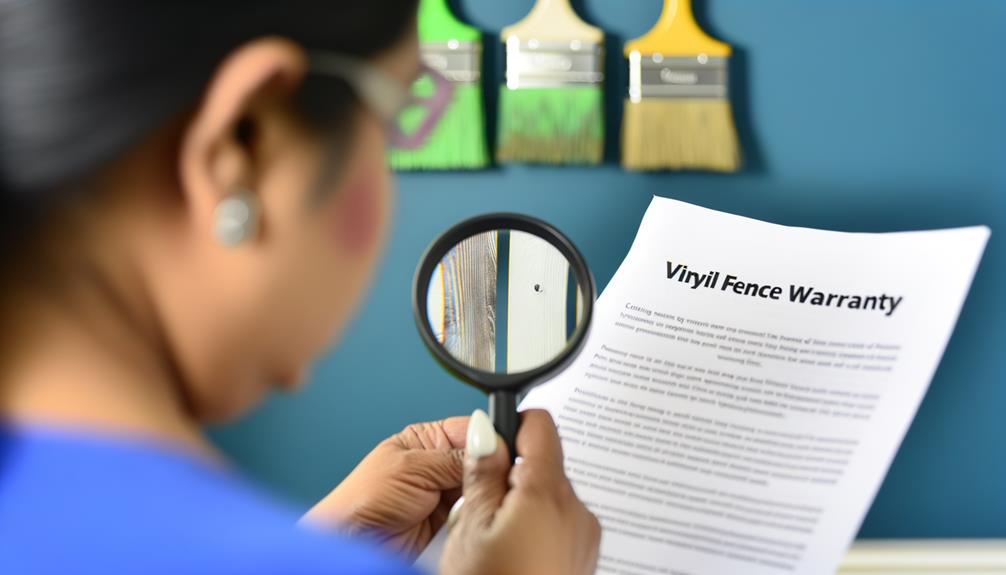
Before we pick up a paintbrush, let’s take a moment to consider our fence’s warranty.
Warranty Coverage Details
Understanding the specific terms and conditions outlined in the warranty document is crucial.
Be sure to note any exclusions or limitations specified, as certain actions, like painting a vinyl fence, could potentially void your warranty. Particular attention should be paid to any requirements related to maintenance and care that could affect the warranty coverage.
It’s always a good idea to contact the manufacturer or supplier for clarification on any warranty-related queries.
In the end, knowing the warranty coverage details helps us make informed decisions about whether or not to paint your vinyl fence.
Warranty Limitations and Exceptions
Having understood the general warranty coverage, we need to focus on the specific limitations and exceptions, particularly around painting your vinyl fence.
Yes, you can paint a vinyl fence, but reviewing the warranty for conditions that may void it is essential. Certain types of paint or improper application could be deal breakers. Always check the manufacturer’s guidelines to fully understand the warranty limitations and exceptions related to painting your vinyl fence.
Be aware painting might void specific parts of the warranty, especially if damage is caused by the paint. Also, understand there may be stipulations regarding alterations to the fence, including painting. We don’t want you to be caught off guard and regret your decision later.
Preparing the Vinyl Fence for Paint
Before we can even think about applying paint, we’ve got to ensure our vinyl fence is prepped and ready.
This involves a thorough cleaning to remove any dirt or grime that could hinder paint adhesion. Once it’s squeaky clean, we’ll apply a special primer made for vinyl surfaces to stave off mold and mildew and promote paint longevity.
Cleaning the Fence
Starting with a thoroughly clean surface is crucial when we’re prepping our vinyl fence for a new coat of paint. We must dedicate ample time to cleaning the fence to ensure a flawless finish. Dust, dirt, and mildew can interfere with the paint’s adhesion, so removing all these residues is essential.
The process isn’t complicated. We’ll need a warm, soapy water bucket and a soft-bristled brush. Gently scrub the fence to avoid scratching the vinyl. A hose or pressure washer can be used for stubborn grime, but remember to keep the pressure low to prevent damage.
Once we’ve finished, we should rinse and leave it to dry completely before painting your vinyl fence.
Priming the Surface
Once our vinyl fence is spotless and completely dry, we can focus on priming the surface to ensure the paint adheres properly and lasts longer. To prepare for this important step, we need to make sure the surface is free of any dirt, mold, or mildew.
An epoxy-based primer is a great choice for durability and adhesion. Using a paint sprayer? Follow the manufacturer’s instructions to the letter.
Our shared goal is to create a fence that looks good and lasts. Let’s take a look at some important steps in the table below:
| Steps | Tools | Result |
|---|---|---|
| 1. Clean Surface | Soapy Water | Dirt-Free |
| 2. Dry Completely | Natural Sunlight | Moisture-Free |
| 3. Apply Primer | Epoxy-Based Primer | Ready for Paint |
| 4. Allow to Dry | Patience | Fully Prepared |
| 5. Paint | Your Chosen Color | Stunning Fence |
Choosing the Right Paint for Vinyl
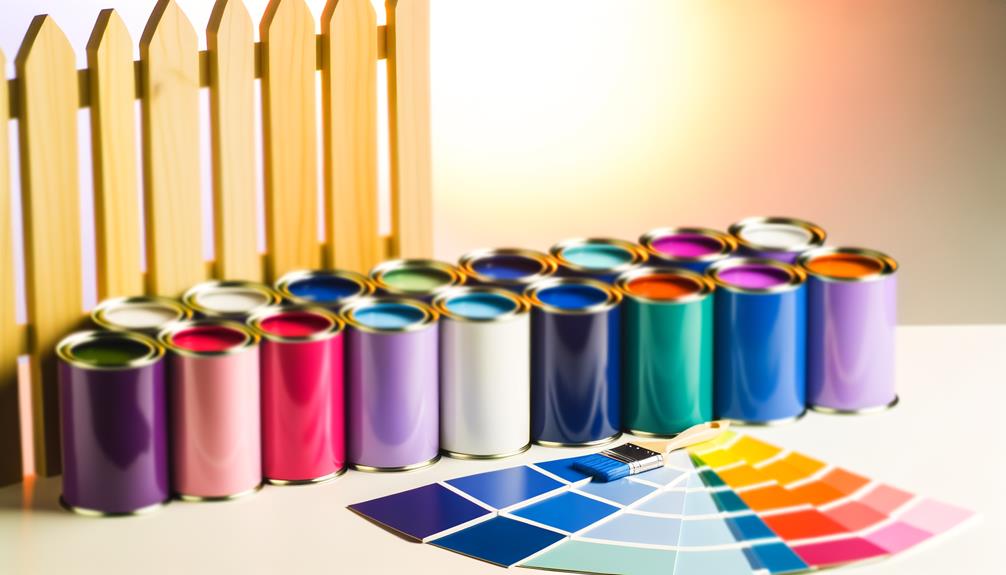
When it’s time to revitalize your vinyl fence, we find that epoxy-based acrylic paints adhere best to the vinyl surface. This type of paint is durable, resistant to chipping and fading, and provides a smooth finish. It’s an excellent choice for use on vinyl due to its strong adhesion properties.
Choosing the right paint for vinyl isn’t just about the type of paint, though. Before you begin, it’s crucial to prepare the surface properly. We recommend using a primer designed specifically for vinyl. This will provide a good base for your paint and prevent mold and mildew growth, ensuring your fence stays fresh for longer.
Cleaning the surface with soapy water and allowing it to dry completely before painting is another essential step. This removes any dirt or grime that could prevent the paint from sticking properly.
Steps to Paint a Vinyl Fence
Having chosen the right paint and adequately prepared the vinyl surface, we’re ready to walk you through the specific steps to paint your vinyl fence effectively. Remember, it’s not just about slapping on some paint, it’s a matter of doing it right to achieve a stunning, long-lasting finish.
Here’s a concise guide:
| Steps | Instructions |
|---|---|
| 1. Cleaning | Start by cleaning the fence with soapy water. Allow it to dry completely. |
| 2. Primer Application | Apply a primer specifically designed for vinyl to prevent mold and mildew growth and improve paint adhesion. |
| 3. Painting | Use an epoxy-based acrylic paint. We recommend using a paint sprayer for an even application. |
| 4. Finishing | Use a durable exterior paint for a long-lasting finish. |
In following these steps to paint a vinyl fence, you’ll ensure a smooth, durable finish that enhances the look of your outdoor space. It’s quite a DIY project, but you’ll find it rewarding with the right approach. So embrace the chance to use the right techniques and watch your fence transform.
Maintenance After Painting Vinyl Fences
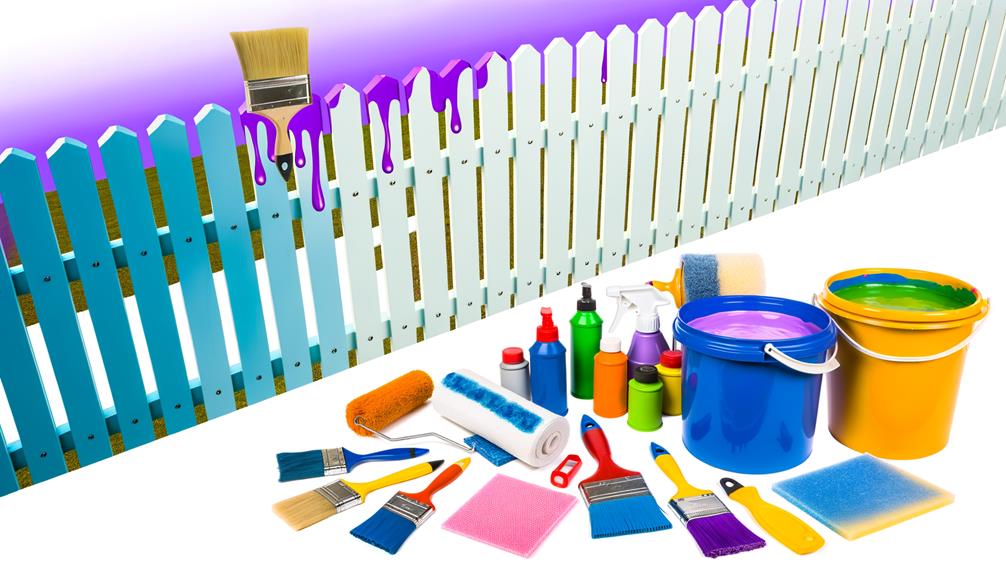
Maintaining a freshly painted vinyl fence is key to ensuring its longevity and appearance. Here’s a guide to help you preserve your fence’s new look:
Regular Cleaning:
- Gentle Cleaning: Use a soft cloth or sponge with a mixture of mild soap and water.
- Avoid Harsh Chemicals: Harsh cleaners can damage the paint and vinyl.
- Rinse Thoroughly: Rinse the fence with clean water to remove any soap residue.
Inspect and Touch Up:
- Regular Inspections: Check for chips, cracks, or peeling paint.
- Immediate Touch-Ups: Quickly address any damage with appropriate paint to prevent further deterioration.
Avoid Physical Damage:
- Trim Nearby Plants: Keep bushes and trees trimmed to avoid scratching or rubbing against the fence.
- Mindful Landscaping: Be cautious with lawnmowers and weed trimmers near the fence.
Weather Considerations:
- Sunlight Exposure: Prolonged exposure to sunlight can cause paint to fade. Consider UV-protective paint for sunny areas.
- Prepare for Winter: In colder climates, ensure the fence is clean and undamaged before winter to prevent weather-related damage.
Long-Term Care:
- Repainting: Depending on exposure and wear, consider repainting every few years to maintain its appearance and protection.
Common Mistakes While Painting Vinyl
Painting vinyl surfaces, such as siding or furniture, can refresh their look, but it’s a task that requires care. Here are common mistakes to avoid:
- Skipping Proper Cleaning: Dirt, grime, or mildew can hinder paint adhesion. Always clean the surface thoroughly before painting.
- Ignoring Weather Conditions: Painting in extreme temperatures or humidity can affect the drying process and final result. Aim for mild, dry weather.
- Using Incompatible Paint: Not all paints adhere well to vinyl. Use paint specifically formulated for vinyl surfaces.
- Neglecting Primer: Although some paints are self-priming, using a primer can enhance adhesion and longevity, especially on weathered or heavily used surfaces.
- Choosing the Wrong Color: Darker colors can absorb more heat, potentially causing the vinyl to warp. Stick to colors similar or lighter than the original.
- Applying Thick Coats: Heavy paint layers may crack or peel. Opt for multiple thin coats instead.
- Rushing the Process: Allow adequate drying time between coats and before using the painted item.
- Overlooking Expansion and Contraction: Vinyl expands and contracts with temperature changes. Use a flexible paint that can accommodate this movement.
- Forgetting to Check the Warranty: Painting might void the warranty of your vinyl product. Always check the manufacturer’s guidelines.
- Neglecting Edges and Crevices: Ensure all areas, including edges and tight spaces, are evenly coated for a uniform appearance.
Avoiding these mistakes can lead to a more prosperous and durable paint job on your vinyl surfaces.
Ignoring Weather Conditions
While painting our vinyl fences, we must not ignore the role weather conditions play in the success of our project. If we choose to paint a vinyl fence in unsuitable weather, we may face issues like peeling, warping, or fading of the new color over time.
| Weather Condition | Impact on Painting |
|---|---|
| High Humidity | Slows down paint drying, leading to poor adhesion |
| High Temperatures | Causes paint to dry too quickly, resulting in cracks |
| Rain | Washes away wet paint, leading to uneven patches |
| Wind | Blows debris onto wet paint, ruining the smooth finish |
Hiring Professionals for Painting
Consider hiring professionals to paint your vinyl fence for a high-quality, long-lasting finish. As experts in the field, these professionals understand the nuances involved in applying a coat of paint to your fence using specific tools and techniques.
Their expertise ensures proper adhesion and durability of the paint, providing you with the best results possible.
Professional painters are equipped with paint sprayers and other necessary tools to coat your vinyl fence evenly and efficiently. This saves you the time and effort of doing it yourself and guarantees a seamless, professional finish.
The convenience doesn’t end there; they handle all the preparation, painting, and cleanup, allowing you to focus on other important tasks.
Beyond the physical task of painting, hiring professionals to paint your vinyl fence offers other valuable benefits. They can provide tailored advice on color choices, maintenance, and alternative options to suit your specific needs. This allows you to make informed decisions and feel a sense of belonging within your home’s aesthetic.
Alternatives to Painting Vinyl Fence
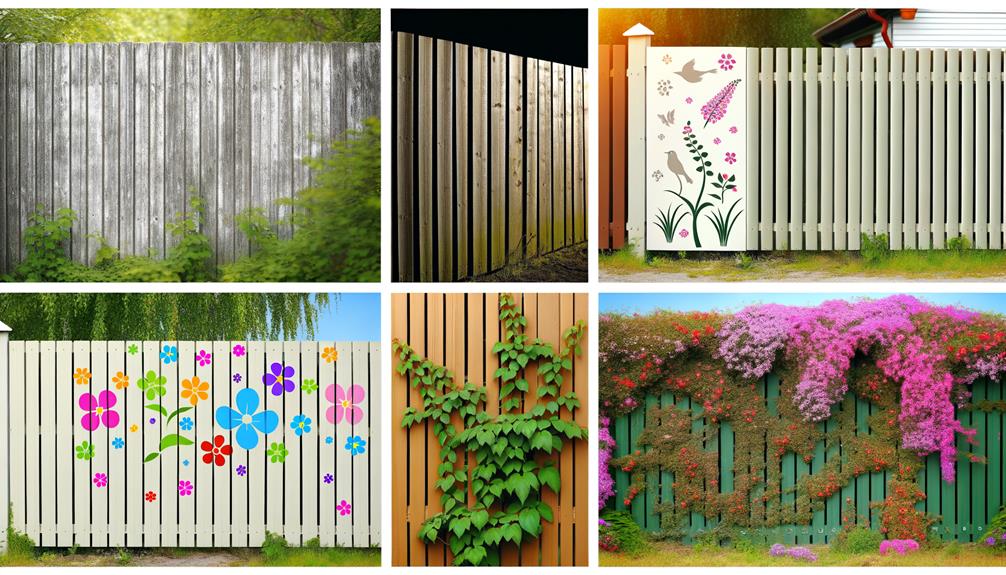
Exploring alternatives to painting can offer fresh and exciting ways to enhance the look of your vinyl fence. Instead of changing the color with paint, we can consider other options to invigorate our fence.
Let’s dive into the alternatives to painting vinyl fence, that can give us the change we desire, without the hassle of paint.
One of the most natural ways is to use climbing vines or decorative shrubbery. They give a refreshing look and add a touch of nature to our homes. Another approach is fence replacement.
We can consider a different material or design that can provide a vibrant color without the need for painting.
| Alternatives | Benefits |
|---|---|
| Climbing Vines | Natural, refreshing |
| Decorative Shrubbery | Adds touch of nature |
| Fence Replacement | Provides vibrant color |
| Twinkle Lights/Hanging Planters | Covers blemishes, adds aesthetic appeal |
Before we resort to painting, let’s explore these alternatives. Also, consulting with fence specialists can provide more customized solutions. Remember, our goal is to create a space where we feel a sense of belonging and joy. So, let’s embrace these alternatives and give our vinyl fence a new lease on life.
Conclusion
While it’s possible to paint a vinyl fence, it’s not always the best choice. Did you know that painting can void your warranty and require more upkeep?
We advise considering all options thoroughly. If you still wish to proceed, ensure you’re using the right paint and preparation methods to avoid common mistakes.
Alternatively, consider hiring a professional or explore other aesthetic enhancements like adding plants or changing fence types.
Your fence, your choice!

